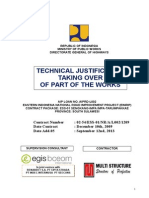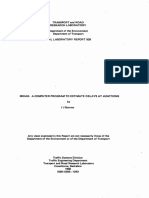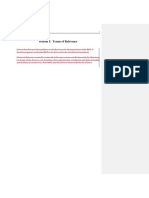Road Design Manual Chapter One Road Design Process: Montana Department of Transportation
Uploaded by
ufffyaarRoad Design Manual Chapter One Road Design Process: Montana Department of Transportation
Uploaded by
ufffyaar18 July 2008
MONTANA DEPARTMENT OF TRANSPORTATION
ROAD DESIGN MANUAL Chapter One ROAD DESIGN PROCESS
December 2000
ROAD DESIGN PROCESS
1(iii)
Table of Contents
Section 1.1 1.2 1.3
Activity Title
Page
FLOWCHARTS ..................................................................................... 1(1) ENGINEERING MANAGEMENT PROCESS ........................................ 1(3) ROAD DESIGN ACTIVITIES................................................................. 1(4)
July 2004
ROAD DESIGN PROCESS
1.1(1)
Chapter One ROAD DESIGN PROCESS Introduction
Chapter One documents the basic approach used by MDT in its road design process and the computer based management system (OPX2) that is utilized to monitor that process. This chapter summarizes the road design activities that occur in the development of a "typical" project. This is followed by a brief description of each activity within the network. In their use of Chapter One, the users should consider the following: 1.1 Flowcharts Flowchart. The flowchart presents a network which graphically illustrates the sequence of activities that occur in the development of typical projects. The following flowcharts are: Road Design Projects Road Design Urban & Rural Reconstruction, Urban & Rural New Construction Road Design Urban & Rural Resurface Road Design Resurface and Widen Road Design Urban & Rural Safety and Spot Improvement Bridge Replacement - Road Design Pavement Preservation
Bridge Projects Bridge Replacement
Traffic Projects Traffic Safety Design
Environmental Projects
Environmental In-House Mitigation Design
1.1(2)
ROAD DESIGN PROCESS
July 2004
Flowcharts may be obtained from Engineering Information Management Section. An evaluation of the scope of the proposed work is necessary to determine the correct flowchart for a specific project. The Road Design Section will usually not have project management responsibility for Bridge, Traffic or Environmental projects. Common exceptions are where traffic safety projects are designed in the Road Design Section and where bridges will be replaced with culverts. 1. Precedence Activity Network. The network of the road design process is a precedence activity network. An "activity" occurs when a significant, discrete event occurs and/or when the responsibility for the project (activity) is transferred from one unit to another. The "precedence" nature of the network implies that an activity cannot occur until all activities preceding that one have been completed. However, the user must be aware that some flexibility is necessary to apply this network to the various types of road design projects. Project Application. The flowchart represents an approximate road design process for a relatively complicated project. Not every activity will be applicable to every project; i.e., some activities will represent "zero" time on relatively minor projects. In addition, some major projects are more complex than illustrated in the network. However, the user should find that projects which are developed according to this process will have fewer management problems. The references to flowcharts and activity descriptions assume a project designed in-house. The process for a consultant-designed project will be similar, except that communication lines exist between MDT and the consultant for MDT review and approval. 3. Lines of Communication. The rigid application of the flowchart would lead to predetermined, precise points at which communication occurs between units. This is neither realistic nor desirable. Communication between units must be continuous. The use of OPX2 does not preclude face-to-face communication. Rather its aim is creating the forum that will encourage it. Hopefully this will result in fewer problems and fewer "surprises" in the road design process. Road Design Emphasis. The objective of the flowchart is to illustrate the interrelationship of activities necessary for the development of a project. The activities on the main stem of the flow chart are the critical path for the shortest project completion time. Other project development elements may become part of the critical path if they are not completed in a timely manner. The user is
2.
4.
July 2004
ROAD DESIGN PROCESS
1.1(3)
referred to the Project Management System manual for detailed descriptions of the activities for other project development elements. 5. Other Manual Chapters. The Montana Road Design Manual contains several other chapters which provide complementary information to Chapter One. The designer should review these chapters for more information on the road design process. In particular, Chapter One should be used in combination with Chapter Two "Road Design Coordination" and Chapter Four "Plan Preparation," which describes the specific content of individual plan sheets. Engineering Management Process
1.2
The Engineering Information Management Section (EIMS) monitors, maintains and updates the OPX2 program which is used to schedule project tasks and monitor preconstruction manpower needs. EIMS is also available to provide technical assistance to managers in statusing their projects. 1. Project Design Managers. Project Design Managers (PDM) are assigned the responsibility to monitor the design of Highway Projects from inception until they are let to contract. Functional Managers. Functional Managers (FM) are assigned the everyday responsibility of completing the project tasks set forth in the OPX2 program schedule.
2.
PDM's and FM's reside primarily in the Highways Bureau, Bridge Bureau, Environmental Bureau, Traffic and Safety Bureau, and District offices. In the Road Design Section the Project Design Manager, acts as both PDM and FM, although Engineering Specialists and Design Supervisors may also be employed as FMs. 1. Preliminary Field Review. Design of projects cannot proceed until the appropriate engineering staff completes a Preliminary Field Review (PFR) and sends a copy to EIMS. Using the PFR as a guide, EIMS creates new projects in OPX2 assigning a template for standardized project types, a temporary project manager, and ready date. The project then shows up on the PDMs list of new projects within OPX2. Project Tasks. The OPX2 program compiles a customized list of tasks and an anticipated man-hour schedule for each project. These tasks must be performed before the submittal of the final plan package to the Contract Plans Bureau. Submittal to FM for Overrides. The PDM reviews the project header information and schedule. If any further changes are needed he/she notifies EIMS. Once
2.
3.
1.1(4)
ROAD DESIGN PROCESS
July 2004
project modifications are completed, the PDM pronounces the project ready to proceed through the override process. 4. Override Process. The FM approves or reworks the tasks using the override process. The override process is performed by adjusting the duration and manhours as dictated by the proposed scope of the project using tools in OPX2. Release of the Project for Design. The FM submits the overrides into OPX2, and after a review of the overrides, the PM releases the approved project schedule back to the FM who manages the project tasks assigned to his/her unit. The FM then is charged with regularly reporting the status of said tasks to the OPX2 system and thus to the PDM.
5.
1.3
Road Design Activities
The following are brief summaries of the tasks that are involved in the activities. The activities are listed in the order in which they occur in the project development. With the exception of Activity 216 and 222 the progression of the activities follow the numerical order. Go to the Engineering Information Services website for complete activity descriptions. 200 Preliminary Field Review Report This activity involves the following Gathering and reviewing background information such as traffic and accident data, preliminary hydraulics information, aerial photos and asbuilt plans Conducting a field review of the project with the appropriate people in attendance (e.g. personnel from various engineering disciplines, environmental, maintenance and district construction) Writing and distributing a report summarizing the proposed project scope, feasible alternatives, engineering decisions, level of environmental involvement, R/W and utility issues, public involvement process and other miscellaneous issues that need to be addressed during the project development.
250
Prepare PFR/SOW Report
July 2004
ROAD DESIGN PROCESS
1.1(5)
This activity combines the tasks of Activity 200 and 214, because projects of this nature have extremely limited potential for change. It includes a field review and a distribution for approval and comments. This activity also includes the submittal of a checklist for the statewide programmatic categorical exclusion if it is appropriate for the project. This activity is used only for pavement preservation projects and other projects of restricted scope. 202 Draft News Release This activity provides the initial public notification that a project is being initiated. The news release outlines the general project scope and begins the public input process. 205 Prepare for Public Involvement This activity involves preparing the information including any visual displays to be presented at a public meeting. It also includes requesting that the Public Involvement Officer schedule a public meeting. 210 Distribute Survey Information and Request Design Input This activity acts as a notification that the survey information is available so that formal design can begin. Design input is also requested from various units on specific issues identified at the Preliminary Field Review. 212 Preliminary Plan Preparation For this activity the designer develops the following: Title Sheet Notes sheet Control Diagram Typical Sections Preliminary plan and profile sheets Preliminary cross sections
1.1(6)
ROAD DESIGN PROCESS
July 2004
For projects where the alignment is not fixed, preliminary horizontal and vertical alignments are provided so that other sections can begin their preliminary design and environmental analysis. 216 Establish Alignment & Grade This activity involves establishing the final horizontal and vertical alignments. After this activity is completed, the adjustments to the vertical alignment should be slight. The alignments may be adjusted to address drainage, environmental, geotechnical, utility or R/W issues. It may also be adjusted to optimize earthwork. This activity also involves finalizing the surfacing section. The subsurface information should be reviewed to determine if it adequately describes the subgrade material for the designed alignment. This activity should address all key design issues and entails extensive coordination with other units. Preliminary plans with surfacing, grading and major drainage features are distributed and the opportunity for a field review is provided. After the changes from the field review are incorporated into the design a reporting documenting the decisions is distributed for comment. On the more complex projects where the alignment is predetermined due to site constraints (e.g. urban reconstruction), this activity is still crucial for resolving key design issues. 214 Prepare Scope of Work Report This activity involves the preparation and distribution of a report that describes in detail the scope of the project. The report establishes the final scope of the project and essentially directs the future development of the project. It includes the decisions and the reasons for the decisions on all major design and construction issues. It also describes environmental commitments, responses to public input and required design exceptions. The report is distributed to the Maintenance and Planning Divisions, Construction, the Bridge, Traffic, Right-of-Way, Environmental and Materials Bureaus and the District for concurrence. It is also distributed to the FHWA for their concurrence on projects where they have full oversight.
July 2004
ROAD DESIGN PROCESS
1.1(7)
222
Approve Scope of Work This activity consists of the addressing comments to the scope of Work Report and resolving all scope-related issues that may not have the concurrence of all appropriate parties. The Chief Engineer approves the final report
218
Prepare Plans for Plan-in-Hand This activity involves the detailed design of all features on the project. It includes the calculation of plan quantities for all items, the preparation of design details, a detailed cost estimate and draft special provisions. When this activity is completed the preliminary plans should be essentially finished and ready for a Plan-in-Hand review.
220
Plan-in-Hand Inspection This activity consists of the distribution of the preliminary plan package and a sheet-by-sheet review of the plans, cost estimate and special provisions. The office review is typically followed by a field review. All items discussed at the office and field review are documented in a Plan-in-Hand Report, which is distributed for comment. The recommendations contained in the report are used by the design personnel to revise the plans, special provisions and cost estimate.
224
Provide Construction Limits to R/W Bureau This activity consists of finalizing the construction limits and all other items that affect the right-of-way such as approach locations and construction permits. The designer furnishes this informant to the Right-of-Way Bureau to assist in the completion of the R/W plans.
228
Design Miscellaneous Features This activity consists of finalizing all elements of the design. These include design details, changes discussed at the Plan-in-Hand, revisions to special provisions and the completion of any items necessary for the environmental permit submittals.
230
Final Plan Review This activity involves the distribution of the completed plan package for review by the appropriate parties, especially District construction personnel. Although this
1.1(8)
ROAD DESIGN PROCESS
July 2004
activity is typically a mail-out of the plan package with comments submitted to the Project Design Manager, a formal review may be scheduled if there are key unresolved items or if major changes occurred at the Plan-in-Hand. The review should address any conflicts between the plans, special provisions and cost estimate. The final plan review should significantly reduce the number of changes that occur when the blue sheet plans are distributed by the Contract Plans Bureau. A Final Plan Review Report is prepared documenting all decisions, revisions and comments. 236 Final Plan Updates and Revisions The designer makes all changes resulting from the Final Plan Review. The designer or Design Supervisor performs a final review of the plans. The designer then submits the plan package to the Checker. 240 Check Plans The checker ensures that the plans package conforms to the Scope of Work Report and the decisions that are documented in subsequent reports. The checker also ensures conformance with current standards, department policy and design practices. The plans package is also checked in detail for accuracy, completeness and consistency. The checker verifies that all corrections and changes are made by the designer. 245 Transmit to Contract Plans Upon completion of the checking process the checker will submit the final plans package in an electronic format to the Contract Plans Bureau. The following activities apply to the development of wetland mitigation sites. Since the tasks associated with these activities are subject to change refer to the Engineering Information Management Section website for full activity descriptions. 242 244 246 Road Design Site Evaluation Design Conceptual Plan Final Mitigation Plan Development
You might also like
- Calculation of The Thurst Force For Pipeline Installation Using DPINo ratings yetCalculation of The Thurst Force For Pipeline Installation Using DPI11 pages
- Model Test and Theoretical Analysis of New and OldNo ratings yetModel Test and Theoretical Analysis of New and Old11 pages
- Highway Capacity Manual 2010: New TRB PublicationNo ratings yetHighway Capacity Manual 2010: New TRB Publication8 pages
- Final Report Volume Iii Design Manual: For Internal Use Only100% (4)Final Report Volume Iii Design Manual: For Internal Use Only59 pages
- DMSI Training Presentation For Closure Dike Construction 14-Nov-2018No ratings yetDMSI Training Presentation For Closure Dike Construction 14-Nov-201830 pages
- Draft Justek V.O 07 Partial Taking OverNo ratings yetDraft Justek V.O 07 Partial Taking Over14 pages
- Kajian Model Hidraulik Kantong Lumpur Bendung Colo Kabupaten SukoharjoNo ratings yetKajian Model Hidraulik Kantong Lumpur Bendung Colo Kabupaten Sukoharjo11 pages
- Points - Sondir - Sutt 150 KV - Ijen Gi Banyuwangi-JatimNo ratings yetPoints - Sondir - Sutt 150 KV - Ijen Gi Banyuwangi-Jatim10 pages
- Rasuwagadhi Hydropower Company Limited: Rasuwagadhi Hydroelectric Project (111 MW)No ratings yetRasuwagadhi Hydropower Company Limited: Rasuwagadhi Hydroelectric Project (111 MW)5 pages
- Static Load Test For Shear Resistance of Framed Walls For Buildings100% (1)Static Load Test For Shear Resistance of Framed Walls For Buildings4 pages
- Laboratorium Teknik Sipil Fakultas Teknik Universitas WiralodraNo ratings yetLaboratorium Teknik Sipil Fakultas Teknik Universitas Wiralodra6 pages
- Plaxis: Computational Geotechnics Course (2D Plaxis Course)No ratings yetPlaxis: Computational Geotechnics Course (2D Plaxis Course)2 pages
- The Case For Personal Rapid Transit (PRT) : PrefaceNo ratings yetThe Case For Personal Rapid Transit (PRT) : Preface8 pages
- LCCA As A Tool For Selection of Highway Pavement TypeNo ratings yetLCCA As A Tool For Selection of Highway Pavement Type60 pages
- CVEEN 4410: Engineering Hydrology: Topic and GoalNo ratings yetCVEEN 4410: Engineering Hydrology: Topic and Goal17 pages
- República Democrática de Timor Leste Ministério Da Solidariedade Social Serviços de Aprovisionamento Tlp. 3311515No ratings yetRepública Democrática de Timor Leste Ministério Da Solidariedade Social Serviços de Aprovisionamento Tlp. 331151548 pages
- Sihayo High - Stage 1 Inception Report - Rev 3 - Contact Details and Other Docs RemovedNo ratings yetSihayo High - Stage 1 Inception Report - Rev 3 - Contact Details and Other Docs Removed198 pages
- Analisis Banjir Way Besai Dengan Model Matematis Unsteady Flow Menggunakan Software HEC-RASNo ratings yetAnalisis Banjir Way Besai Dengan Model Matematis Unsteady Flow Menggunakan Software HEC-RAS16 pages
- References - The Design of Prestressed Concrete BridgesNo ratings yetReferences - The Design of Prestressed Concrete Bridges4 pages
- River Training Works - Method Statement: 1.0 The Project SynopsisNo ratings yetRiver Training Works - Method Statement: 1.0 The Project Synopsis56 pages
- CV Tommy Compressed Compressed-CompressedNo ratings yetCV Tommy Compressed Compressed-Compressed47 pages
- Forecasting Final Budget and Duration of Highway Construction ProjectsNo ratings yetForecasting Final Budget and Duration of Highway Construction Projects16 pages
- Plunge Pool Rock Scour Experiences and Analysis Techniques: Abstract100% (1)Plunge Pool Rock Scour Experiences and Analysis Techniques: Abstract10 pages
- Manual On Uniform Traffic Studies-Intersection Delay Chapter 7No ratings yetManual On Uniform Traffic Studies-Intersection Delay Chapter 74 pages
- The Standard Methods of Measurements For Building Works in The Construction Industry Esb 300100% (4)The Standard Methods of Measurements For Building Works in The Construction Industry Esb 3005 pages
- Paper - Kajian Karbonasi Pada Beton Mutu Tinggi Memadat MandiriNo ratings yetPaper - Kajian Karbonasi Pada Beton Mutu Tinggi Memadat Mandiri12 pages
- A Guide To Variable Message Signs (VMS) and Their UseNo ratings yetA Guide To Variable Message Signs (VMS) and Their Use16 pages
- 2016 Chapter 3 Geotechnical Investigation and SamplingNo ratings yet2016 Chapter 3 Geotechnical Investigation and Sampling23 pages
- Development of Building Reliability System Based On Regulation of The Minister of Public Work Number 24PRTM2008No ratings yetDevelopment of Building Reliability System Based On Regulation of The Minister of Public Work Number 24PRTM20086 pages
- NO.36 Method Statement For Pile Cap Construction in Nilwala No.02 Bridgerev.B.No ratings yetNO.36 Method Statement For Pile Cap Construction in Nilwala No.02 Bridgerev.B.24 pages
- Guideline For Preparation of DPR Road and Bridge Projects100% (1)Guideline For Preparation of DPR Road and Bridge Projects15 pages
- Calculation of The Thurst Force For Pipeline Installation Using DPICalculation of The Thurst Force For Pipeline Installation Using DPI
- Model Test and Theoretical Analysis of New and OldModel Test and Theoretical Analysis of New and Old
- Final Report Volume Iii Design Manual: For Internal Use OnlyFinal Report Volume Iii Design Manual: For Internal Use Only
- DMSI Training Presentation For Closure Dike Construction 14-Nov-2018DMSI Training Presentation For Closure Dike Construction 14-Nov-2018
- Kajian Model Hidraulik Kantong Lumpur Bendung Colo Kabupaten SukoharjoKajian Model Hidraulik Kantong Lumpur Bendung Colo Kabupaten Sukoharjo
- Points - Sondir - Sutt 150 KV - Ijen Gi Banyuwangi-JatimPoints - Sondir - Sutt 150 KV - Ijen Gi Banyuwangi-Jatim
- Rasuwagadhi Hydropower Company Limited: Rasuwagadhi Hydroelectric Project (111 MW)Rasuwagadhi Hydropower Company Limited: Rasuwagadhi Hydroelectric Project (111 MW)
- Static Load Test For Shear Resistance of Framed Walls For BuildingsStatic Load Test For Shear Resistance of Framed Walls For Buildings
- Laboratorium Teknik Sipil Fakultas Teknik Universitas WiralodraLaboratorium Teknik Sipil Fakultas Teknik Universitas Wiralodra
- Plaxis: Computational Geotechnics Course (2D Plaxis Course)Plaxis: Computational Geotechnics Course (2D Plaxis Course)
- The Case For Personal Rapid Transit (PRT) : PrefaceThe Case For Personal Rapid Transit (PRT) : Preface
- LCCA As A Tool For Selection of Highway Pavement TypeLCCA As A Tool For Selection of Highway Pavement Type
- República Democrática de Timor Leste Ministério Da Solidariedade Social Serviços de Aprovisionamento Tlp. 3311515República Democrática de Timor Leste Ministério Da Solidariedade Social Serviços de Aprovisionamento Tlp. 3311515
- Sihayo High - Stage 1 Inception Report - Rev 3 - Contact Details and Other Docs RemovedSihayo High - Stage 1 Inception Report - Rev 3 - Contact Details and Other Docs Removed
- Analisis Banjir Way Besai Dengan Model Matematis Unsteady Flow Menggunakan Software HEC-RASAnalisis Banjir Way Besai Dengan Model Matematis Unsteady Flow Menggunakan Software HEC-RAS
- References - The Design of Prestressed Concrete BridgesReferences - The Design of Prestressed Concrete Bridges
- River Training Works - Method Statement: 1.0 The Project SynopsisRiver Training Works - Method Statement: 1.0 The Project Synopsis
- Forecasting Final Budget and Duration of Highway Construction ProjectsForecasting Final Budget and Duration of Highway Construction Projects
- Plunge Pool Rock Scour Experiences and Analysis Techniques: AbstractPlunge Pool Rock Scour Experiences and Analysis Techniques: Abstract
- Manual On Uniform Traffic Studies-Intersection Delay Chapter 7Manual On Uniform Traffic Studies-Intersection Delay Chapter 7
- The Standard Methods of Measurements For Building Works in The Construction Industry Esb 300The Standard Methods of Measurements For Building Works in The Construction Industry Esb 300
- Paper - Kajian Karbonasi Pada Beton Mutu Tinggi Memadat MandiriPaper - Kajian Karbonasi Pada Beton Mutu Tinggi Memadat Mandiri
- A Guide To Variable Message Signs (VMS) and Their UseA Guide To Variable Message Signs (VMS) and Their Use
- 2016 Chapter 3 Geotechnical Investigation and Sampling2016 Chapter 3 Geotechnical Investigation and Sampling
- Development of Building Reliability System Based On Regulation of The Minister of Public Work Number 24PRTM2008Development of Building Reliability System Based On Regulation of The Minister of Public Work Number 24PRTM2008
- NO.36 Method Statement For Pile Cap Construction in Nilwala No.02 Bridgerev.B.NO.36 Method Statement For Pile Cap Construction in Nilwala No.02 Bridgerev.B.
- Guideline For Preparation of DPR Road and Bridge ProjectsGuideline For Preparation of DPR Road and Bridge Projects



























































